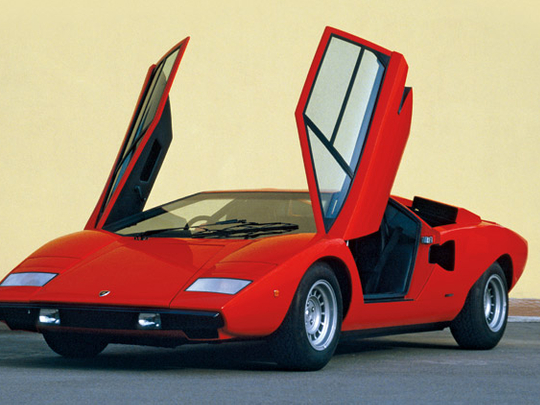
"Countach!" Legend has it that Italian design guru Nuccio Bertone blurted out this exclamation the first time he saw the car codenamed Project 112 at his design studio. A word used to express astonishment in the Piedmontese dialect, the name stuck to the Lamborghini that went on to be the most outrageous and legendary supercar ever.
Penned by Bertone's young designer Marcelo Gandini, who at that time had little experience in styling practical cars, the Countach was unlike anything before it. Extremely wide, impossibly low, and with a wedge-shaped body made of trapezoidal frames, the Countach LP500 prototype sported ‘scissor doors' that tilted upwards rather than sideways. Although Gandini had incorporated these unconventional doors in his 1968 Alfa Romeo Carabo concept, they became a real hit in the Countach and a trademark feature of Lambos since then.
Originally meant to be powered by a 5.0-litre V12 longitudinally positioned in the middle (that's why the prototype unveiled at the 1971 Geneva show was called LP500), an engine blowout during testing forced Lamborghini to return to the more reliable 4.0-litre unit based on the one tried and tested in the Miura. Renamed LP400, the first batch of production Countach models came out in 1974 with a 374bhp engine. Apart from larger air scoops to cool the unit, the LP400 retained most of the styling attributes of the prototype. The car was designed to wear Pirelli P7 tyres that were under development at the same time, but since they weren't ready, the LP400 was shod with narrower tyres, making it faster than the iterations that followed.
In 1978 Lamborghini brought out the more aggressive LP400S, featuring the ridiculously wide 345mm P7 rubber, and just 1bhp more from the engine (but higher revs, too). Wider tyres meant fibreglass wheel arch extenders and changes to the suspension. However, combined with an optional rear spoiler, these made it slower than the LP400.
For the next upgrade, Lamborghini tried a turbo version of the 4.0-litre unit, but had to abandon it due to cooling issues. Instead it increased the displacement to 4.8 litres by redesigning the combustion chambers and enlarging the bore and stroke. Thus the LP500S was born in 1982, retaining the same design, but sporting aluminium alloy wheels in place of the more expensive magnesium ones in the 400S.
In 1985, Lambo introduced the ‘Super Countach', the LP500QV (Quattrovalvole, meaning four valves per cylinder) to counter Ferrari's 385bhp Testarossa. And it beat it hands down with its 448bhp 5.2-litre unit. The QV featured Weber downdraft carburettors, making the engine cover higher and visibility even lower. With its rear wing and larger front tyres, the LP500QV is considered by many as the best looking Countach. Although the wing did nothing to improve the car's aerodynamics, almost all 500QVs sold had it, despite it being an expensive option.
Lamborghini had planned the Diablo as its 25th anniversary special, and subsequently the Countach's successor. As the Diablo wasn't ready in time though, Sant'Agata decided to make a Countach special edition. So in 1988 came the 25th Anniversary Countach, which was intended to be a limited edition, but went on to become the largest-selling, with 667 finding homes. Based on the QV's chassis, the 25th Anniversary was a toned down version of the latter, with a slight redesign and extra cooling vents for the front and rear brakes. It was a befitting swansong for a legend that radically altered the idea of a supercar and reigned as the undisputed class leader for 17 years, until it was finally replaced by the worthy Diablo.
Legends - leg·ends \'le-j nds\ -noun Myths, folklores, marvels and wonders of the most storied culture of all — car culture











